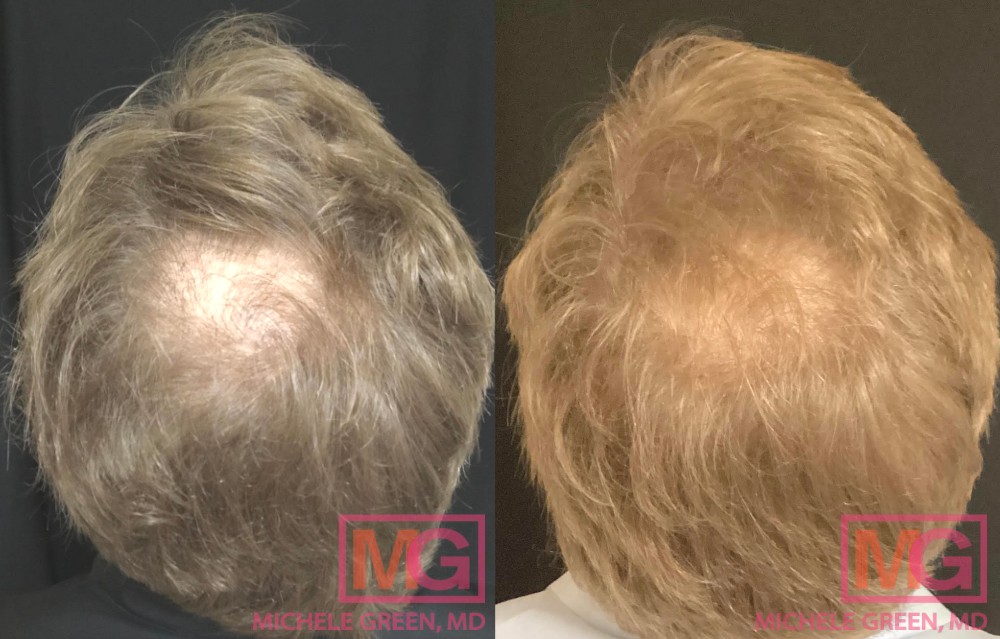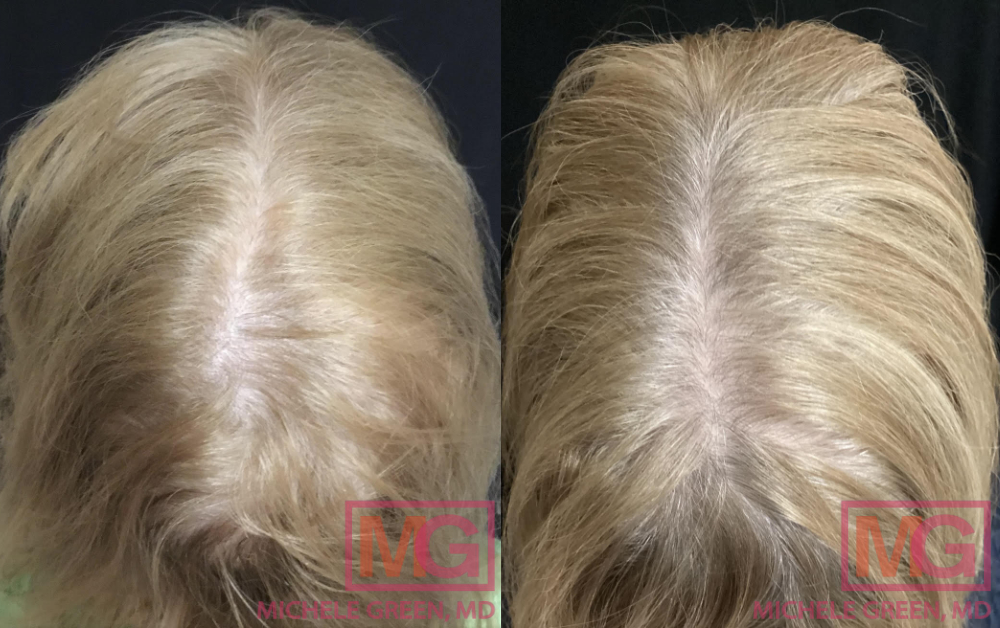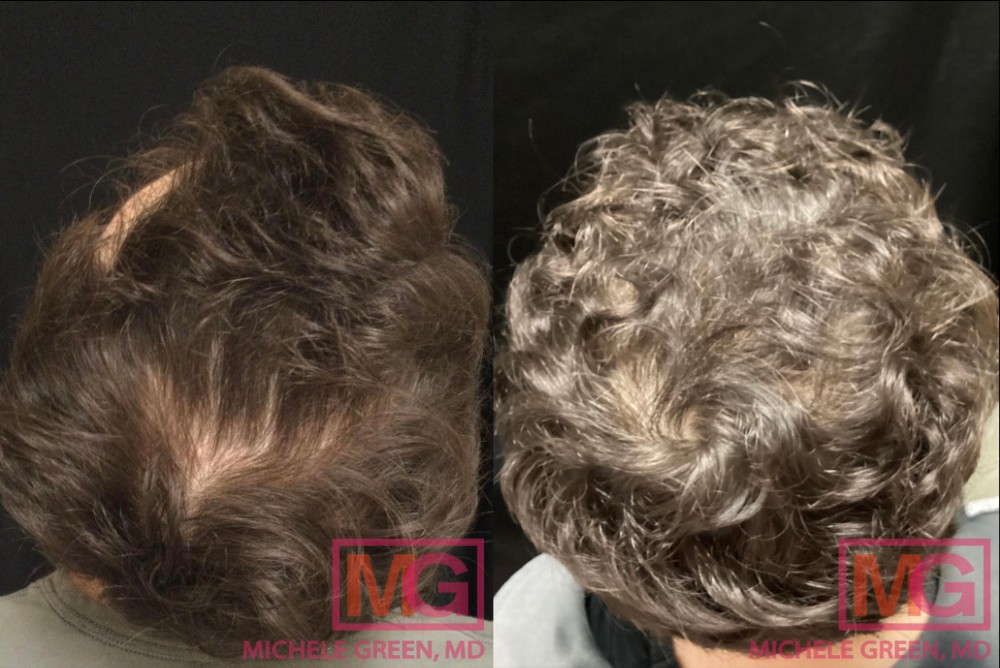How Effective Is PRP For Hair Loss?
Hair loss is a common and distressing condition that affects approximately 50 million men and 30 million women. A result of age, stress, genetics, or an auto-immune condition, acute or pattern hair loss can lead to insecurity and even depression symptoms in those that experience it. While there seem to be many hair loss treatments and supplements available on the market, it can be very hard to tell which are actually effective, and even those topical or oral medications that work well can cause undesirable side effects. For a long time, many believed that the most effective course of action was a plastic surgery hair transplant, however many patients worry about the significant side effects associated with going under the knife. Luckily, board-certified, expert dermatologist, Dr. Michele Green, has a non-surgical option that works to prevent hair loss: platelet-rich plasma, or PRP, treatment.
Platelet-rich plasma therapy works through the use of the patient’s own blood to strengthen hair follicles and promote hair growth. Commonly used to accompany microneedling, the many benefits of PRP treatment include promoting wound healing and increasing stem cell growth. When injected into areas of the scalp as a part of the treatment plan for hair loss, PRP therapy improves hair thickness, lengthens the growth phase of hair follicles, and encourages overall rejuvenation of the scalp. PRP is considered an excellent treatment option due to the effectiveness of the treatment, the lack of downtime required, and minimal side effects.
When it comes to hair loss treatment, it is best to consult an experienced, board-certified dermatologist, such as Dr. Green. Dr. Green has been effectively treating patients in her Upper East Side New York City dermatology office for more than 25 years. An expert in a wide range of medical and cosmetic procedures, Dr. Green has been praised by many patients for her proficiency in such treatments as Botox injections, dermal fillers, laser therapy, microneedling, and much more. Known for her high patient satisfaction, Dr. Green has been voted one of the best healthcare providers in New York City by such publications as Castle Connolly, New York Magazine, and Super Doctors.

What is Platelet-Rich Plasma (PRP)?
Platelet-rich plasma (PRP) therapy is a modern treatment that uses the growth factor proteins found in the patient’s own blood to promote healing, strengthen and encourage growth of new cells, and assist with blood clotting. PRP treatment is commonly used for various medical needs, specifically to aid with the healing of wounds or musculoskeletal injuries, for rejuvenation of the skin, and to prevent hair loss. PRP treatment is now being commonly used by dermatologists to address such hair loss conditions as male pattern baldness or female pattern baldness – also known as androgenetic alopecia – and alopecia areata. While the treatment is not currently FDA approved to treat hair loss, the procedure still helps to prevent thinning hair and promotes new hair growth with long-lasting results.
How does PRP for hair loss work?
PRP for hair loss works through the injection of the high platelet count plasma found in the patient’s blood into the area of the scalp where hair loss is beginning to show. This platelet-rich plasma works to activate proteins in the body called “growth factors,” which serve a variety of helpful purposes. When it comes to prevention of hair loss, growth factors can work to improve circulation in the treatment area, which can help to thicken the hair follicle. As a result, the new hair growth at the injection site is thicker and healthier looking. Furthermore, these growth factors can help to heal and reactivate hair follicles, increasing hair count in the area. The proteins also work to stimulate the papilla cells, which help to promote new hair growth. Altogether, this means that PRP treatment works to strengthen the hair follicle for thicker hair and activate previously inactive hair follicles for new growth, which serves to counteract hair loss.
What is the procedure for PRP hair restoration?
As PRP hair restoration works via the injection of the patient’s own platelet-rich plasma into the scalp, the procedure for PRP therapy begins with drawing blood from the patients arm. When you arrive in the office, Dr. Green will draw your blood and place it in a centrifuge, which works to separate the blood into three components: platelet-poor plasma, platelet-rich plasma, and red blood cells. The platelet rich plasma is then extracted for injection into the scalp. An hour before the injection itself, Dr. Green will apply a topical numbing cream to the treatment area in order to prevent any potential discomfort as a result of the injections. Then the PRP is injected into the treatment areas of the scalp, using a small needle containing an anticoagulant, in order to increase the number of growth factors found in that area. The treatment itself is quick and simple, usually only taking 30 minutes total, and there is no downtime necessary, meaning patients can immediately return to their regularly scheduled activities. After the first treatment, Dr. Green’s office will help to schedule your follow-up and maintenance treatments.
How long does PRP last for hair loss?
PRP for hair loss has long lasting results but will typically require maintenance treatments in order to maintain the effects long term. The PRP therapy can have effects that last as long as 18 months after the initial round of injection treatments, however, Dr. Green recommends getting a touch-up treatment approximately once a year in order to maintain the full results of the treatment. At your follow-up appointment with Dr. Green, her office will help to schedule the regular maintenance treatments to keep your hair growth full and strong.

How often can you get PRP injections for hair loss?
The first round of PRP injections for hair loss prevention and scalp rejuvenation typically involve two to three injection sessions each spaced four to six weeks apart. Multiple injections are necessary for the best results and in order to maintain the effects of the treatment, patients often require a maintenance treatment series once a year. It can take several weeks for the full effects of the treatment to be apparent after each round of treatments. Most patients will experience a natural thickening and regrowth of hair in the weeks following the procedure, though the peak of collagen production typically occurs approximately three months after the injections.
Does PRP work to stop hair loss?
PRP has been demonstrated in several key studies to stop hair loss from occurring and to promote new hair growth. A study published in the Journal of Cutaneous and Aesthetic Surgery in 2014 (doi: 10.4103/0974-2077.138352) demonstrated that when PRP was injected into the scalp every other week for three months, that number of hair follicles increased, promoting healthier hair growth. In 2019, a study published in the International Journal of Trichology (doi: 10.4103/ijt.ijt_64_18) compared the effects of PRP treatment with the effects of topical minoxidil, also known as Rogaine. The study demonstrated that PRP was more effective at preventing hair loss than Rogaine was and had fewer side effects.
When compared with other treatments, such as topical minoxidil and oral finasteride (Propecia), PRP frequently performs better and is not associated with the same frustrating side effects. For men, such medications can often lead to side effects, such as erectile dysfunction, and for women, side effects can include facial hair growth and low blood pressure. For that reason, PRP is quite often the best option for preventing hair loss.
Does PRP regrow hair?
PRP treatment is highly effective in preventing hair loss and hair thinning, and also works to regrow hair and promote thicker, healthier hair growth. There are various types of hair loss conditions that can occur, which can cause the hair follicles to become weak and inactive. With platelet-rich plasma treatment, the growth factors present in the injection help to reactivate hair follicles and promote hair regrowth at the injection site. For patients who are dealing with balding in varying forms, Dr. Green will often recommend PRP therapy to reverse signs of hair loss.
What is PRP treatment for androgenic alopecia?
Androgenic alopecia, often commonly referred to as male-pattern baldness, is a common condition that can affect both men and women. Androgenic alopecia often follows a predictable receding of the hairline – for men, the loss of hair begins near the temples, forming the characteristic “M” shape of the hairline, and can also occur on the crown of the head. For women, alopecia typically begins with hair thinning on the top of the head, which contributes to a widening of the part. The condition is related to increased levels of androgen hormones, which can affect the hair growth cycle and the hair follicles, leading to thinning hair and general hair loss. PRP treatment is an effective way to address androgenic alopecia to counteract the negative effects of the increased hormone levels. When PRP is injected into the area of the scalp where thinning is occurring, the treatment works to strengthen the hair follicles for thicker hair regrowth.
How does PRP therapy work for alopecia areata?
Alopecia areata is another form of alopecia that can occur. The condition is an auto-immune disorder that causes the body to damage its own hair follicles, which can lead to hair loss anywhere on the body, including the scalp. As the body’s white blood cells attack the hair follicles, it causes hair growth to slow dramatically and hair to fall out. Generally, alopecia areata occurs in patches, meaning that the hair loss is irregular. Alopecia areata can be unpredictable and can happen to patients of any age or gender, and is linked to a genetic component, rather than any acute traumatic or stressful incident. For some patients, hair regrowth may occur within 12 months and then hair loss will not happen again but it is difficult to determine the pattern. Luckily, PRP can help with the hair regrowth process by activating growth factor proteins to strengthen hair follicles and increase hair count for increased growth.
How much does PRP for hair loss cost?
When patients ask, how much for PRP treatment, the answer is: it depends. Treatment cost can vary based on your geographic location, the type of institution at which you receive treatment, and the severity of hair loss and size of the treatment area. While seeking treatment from an expert, board-certified dermatologist, such as Dr. Green, may be more expensive than receiving treatment from a less experienced practitioner, the risk of developing serious side effects greatly decreases when you receive treatment from an expert. The number of treatments can also have an effect on the full price of each round of treatments, and number of treatment sessions needed can depend on the size and scope of the treatment area as well as the condition being treated. After your initial consultation with Dr. Green, her office will be able to provide you with a clearer estimate of the cost of the treatment based on these factors.

Is PRP treatment for hair regrowth safe?
PRP treatment is a very safe and effective treatment for hair regrowth and hair loss prevention. Unlike other hair loss prevention treatments, PRP therapy is associated with very few side effects, especially when the procedure is performed by a board-certified dermatologist, such as Dr. Green. Part of the reason for the lack of side effects is that PRP treatment uses plasma from the patient’s own blood, meaning that there is no risk for an allergic reaction. PRP treatment is quick and easy to perform and requires no downtime, meaning that patients can immediately resume their regularly scheduled activities after their appointment.
What are the side effects of PRP therapy for hair growth?
The risk of experiencing side effects as a result of PRP therapy is low, especially when you receive treatment from an expert dermatologist, such as Dr. Green. A common and mild side effect that patients may experience is slight soreness or redness at the injection site, which should resolve on its own after several days. When seeking treatment from a less experienced injector, the risk of developing more severe side effects increases. Patients of inexperienced practitioners may be at a higher risk of blood vessel or nerve damage on the scalp, scarring or calcification of tissue, and infection at the injection site. If you have a history of severe scarring, be sure to inform Dr. Green before receiving treatment.
How to get started with PRP therapy for hair loss treatment today
If you are experiencing hair loss, you are not alone – millions of Americans battle with hair loss every year. Hair loss can feel very distressing, as many patients identify deeply with their hair and balding can represent the worst of the natural aging process. Luckily, Dr. Green can help prevent hair loss, hair thinning, and balding through the use of platelet-rich plasma therapy. PRP treatment helps to strengthen and activate hair follicles for thicker hair and hair regrowth. Develop your customized hair loss treatment plan with Dr. Green today and call our NYC office at 212-535-3088 or contact us online
 212-535-3088
212-535-3088